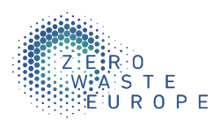“The CEAP is a nice patchwork of initiatives pointing in the right direction. Now the EU has to glue the pieces together to ensure that circular zero waste activities are more convenient and economic than the current, failing, linear ones“, commented Joan Marc Simon, Executive Director, Zero Waste Europe
Specifically, ZWE welcomes the proposal to create an overarching sustainable product policy framework as a way to ensure that products which are either short-lived, toxic, unrepairable, unrecyclable or simply untraceable, are phased out from the EU market. However, from a systemic perspective, a sustainable product strategy isn’t enough to deliver a sustainable Europe .
The newly presented CEAP is framed to make products, food and packaging sustainable and, whilst this sentiment is welcome, it doesn’t go far enough. There is no such thing as sustainable products or foods, there are only sustainable systems . In nature, the sustainability of ecosystems is not related to the qualities of the parts but rather to how they interact with each other as a whole. It is therefore important to complement the product policy framework with one that fosters prevention and reuse operations in order to ensure that a “sustainable product” will not be wasted in a system designed for single-use activities .
ZWE also supports the proposal to develop waste prevention targets, expanding the use of Extended Producer Responsibility tools and restricting waste exports outside the EU. However there are loopholes in the current CEAP which threaten the transition to a real circular economy .Specifically, the 10% landfill target which actually works against waste prevention and pushes member states to invest in incineration facilities when they should be focusing on separate collection, reuse and recycling infrastructures.
Moreover, waste trade inside EU borders lacks transparency and traceability and an equivalent to the European Circular Dataspace for waste, using the EU Digital agenda, would be needed to stop intra-European dumping and downcycling as well as guarantee that recycled content is safely reintroduced in the production cycles.
Finally, ZWE welcomes the level of ambition and the holistic approach used by the Commission on the CEAP. However, time is of the essence. If the EU is to enable a “reuse revolution” it should organise how reuse markets are going to operate at European level .
Whilst it is good to see that some member states are moving ahead with the development of standards and tools for reuse, it is problematic that this is happening when a European framework or guidance are not in place.
“There is an opportunity to have technical and economic standards developed at the European level that allow reuse to flourish beyond national borders. However, the later the EU intervenes in this field the more difficult and costly it will be”, concluded Mr. Simon.





